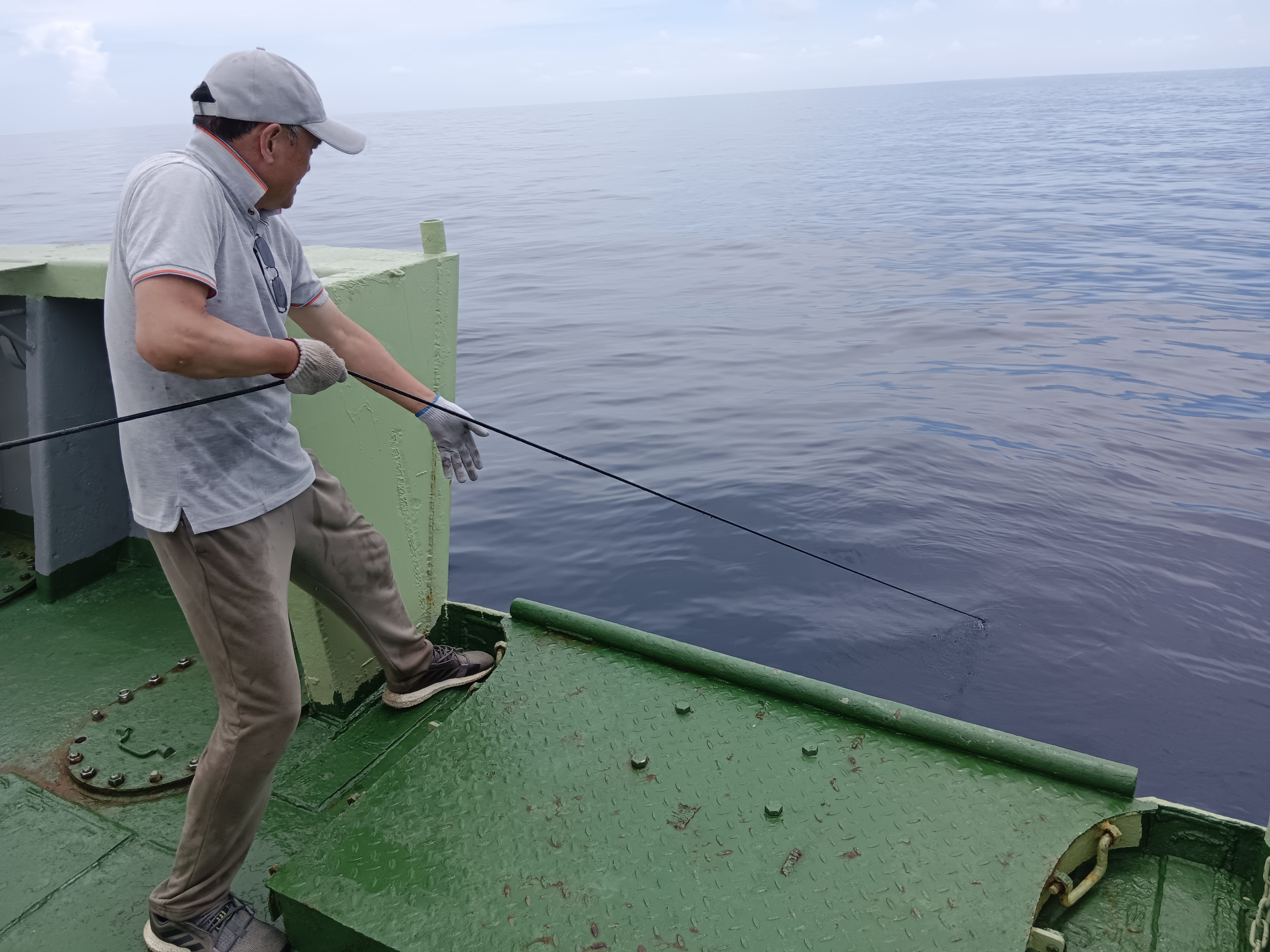“万物生长靠太阳”。太阳提供的能量,也即光,驱动、维系着整个地球系统的运转。故而海洋中的物质成分以及海水的运动,都与光有着千丝万缕的联系。反过来,也就使得光谱成为一个信使,通过分析光谱,能够推算光在水体中的传输,开展更趋真实的海洋热量收支衡算;推演计算浮游植物色素、类群结构及至初级生产力,掌握全球尺度海洋碳循环关键环节的形貌及变化。这便是建立在海洋光学理论上的水色遥感,自上世纪七十年代以来,随着卫星航天技术的蓬勃发展,给海洋科学带来了革命性的变化。
李忠平教授沉浸在这一领域,与光共舞、追光不息30余年,主要学术贡献包括:
(1) 传统的水色遥感以浮游植物叶绿素浓度为中心,统计回归是基本手段。李忠平教授指出该遥感体系在时间、空间上的局限性以及参数间的不自洽,进而依据辐射传输理论建立了以固有光学特性为中心的水色遥感体系;
(2) 研发了系列水色反演算法,被纳入美国NASA 和欧洲ESA标准卫星数据处理系统。其中QAA算法一文刊载于国际应用光学杂志 (Applied Optics),入选其创刊50年来最具影响力文章之一;
(3) 海水透明度是一有约160年观测历史的海洋环境光学参数,其理论解释始于上世纪50年代,一直被奉为经典,但鲜有人留意并思考该理论为何不能解释全球范围内基于测量获得的规律。直至2014年,李教授发现该理论推导中的错误,提出了全新的海水透明度理论,推翻“经典”,得到了与现场测量完全相符的规律。

图1:李忠平教授于2021年6月11日在“海丝二号”小卫星发射现场
他同时倾力推动中国水色遥感学科发展:主导研制、发射国际首颗大幅宽、高分辨率、高信噪比水色小卫星“海丝二号”;合作推出、发行属于中国的第一份国际遥感杂志Journal of Remote Sensing;发起、组织水色遥感暑期班,打造培养水色遥感科研新军的“黄埔军校”;发起、组织编写水色遥感入门教科书《水色学概览》,宣传水色遥感并引导青年学子投身水色科学研究。

图2:李忠平教授参加2023年6月的南海北部海域航次
李忠平教授目前的工作重点主要包括两个方面:
其一,发展初级生产力新型遥感模型。构筑以光学特性为中心、建立在坚实的物理基础-光合作用机理上的初级生产力遥感模式,以提高气候变化背景下对全球尺度初级生产力时空变化的认知与理解,贡献于碳循环的科学研究,同时为国家的双碳战略提供数据支撑;
其二,“海丝星座”建设。抓住微纳卫星技术蓬勃发展的契机,锁定直接受人类活动影响、而传统水色卫星观测能力受限的近海与内陆湖泊,构建多星组网的海丝小卫星星座,以丰富、高分辨、高精度的观测数据提升近海及内陆湖泊的科学研究,并支撑“一带一路”沿线海洋经济和区域发展。
李忠平博士,1984年本科毕业于四川大学物理系光学专业,1994年于美国南佛罗里达大学获博士学位,主攻光学遥感。先后任职美国海军实验室研究员、美国麻省州立大学波士顿分校教授,国际水色协调组(IOCCG)海洋光学暑期班常任授课专家。2018年当选美国光学学会会士 (OSA fellow) ,2022年受聘5123导航唐世凤海洋学科讲席教授。已发表学术论文170余篇,Google Scholar引用次数逾2万次,H-index 67。主持在研国家自然科学基金外国资深学者研究基金项目、国家自然科学基金重点项目各1项,已主持完成科技部重点研发计划项目课题、国家自然科学基金面上项目各1项。
|
Zhongping Lee:A Light Chaser
"All things grow with the sun." The energy provided by the sun, namely light, drives and maintains the entire Earth system. Therefore, the composition of substances in the ocean and the movement of seawater are closely related to light. Conversely, this makes the light spectrum a messenger. By analyzing the spectrum, the transmission of light in the water can be calculated, and a more realistic evaluation of heating of the ocean by the sun can be obtained. Further, estimations of phytoplankton pigments, functional types, and primary productivity can be achieved, which subsequently help the quantification and understanding of carbon cycle in the ocean. This is the remote sensing of ocean (water) color established based on the theory of ocean optics. Since the 1970s, with the rapid development of satellite technology, it has significantly advanced ocean sciences.
Dr. Zhongping Lee has been immersed in this field for over 30 years, “dancing” with and chasing the light endlessly. His major academic achievements include:
(1) Traditional ocean color remote sensing is centered on the concentration of phytoplankton chlorophyll, and statistical regression is the common approach. Dr. Lee pointed out the limitations of this remote sensing system in time and space, as well as the inconsistency between/among parameters. Based on radiative transfer theory, he established an ocean color remote sensing system centered on inherent optical properties.
(2) He has developed a series of ocean color inversion algorithms, which have been included in the standard satellite data processing systems of NASA and ESA. Among them, the QAA published in Applied Optics was selected as one of the most influential articles in her 50-year history.
(3) The transparency of seawater has a history of observation of about 160 years, where its theoretical interpretation was initiated in the 1950s and a classical theory was established. However, fewer researchers have paid attention to and considered why this theory cannot explain the relationships obtained based on measurements on a global scale. It was not until 2014 that Dr. Lee pointed out the error in the derivation of this classical theory and proposed a new theory which perfectly interpreted field measurements, thus overturned the classical theory.
Dr. Lee has made great efforts to promote the development of China's ocean color remote sensing discipline. He led the development and launch of the world's first wide-swath, high-resolution, and high signal-to-noise ratio multi-band smallsat "HiSea II". He also helped the launch and operation of the first international remote sensing journal from China, the "Journal of Remote Sensing". He initiated and organized the summer school of ocean color remote sensing, creating a "Huangpu Military Academy" to cultivate new forces in ocean color remote sensing research. He also initiated and organized the compilation of the introductory textbook "Overview of Ocean Color Science", to promote ocean color remote sensing and guide young scholars to engage in ocean color scientific research.
Dr. Lee’s current activities mainly focuses on two aspects:
Firstly, developing a new remote sensing model for primary productivity. By constructing a remote sensing model for primary productivity centered on optical characteristics and based on the first principle of photosynthesis, he aims to improve the characterization and understanding of primary productivity at global scale under the background of climate change, which will greatly help scientific researches on carbon cycling, and provide data to support the country's dual-carbon strategy.
Secondly, the construction of a "Maritime Silk Road Constellation". Seizing the opportunity of the booming development of micro-nano satellite technology, this initiative aims to build a multi-satellite constellation, targeting the nearshore waters and inland lakes that are directly affected by human activities and that the capabilities of traditional ocean color satellites are limited. The constellation will provide rich, high-resolution, and high-precision observation data to enhance scientific research in the nearshore-water and inland-lake ecosystems, and support the development of maritime economy and regional development along the Belt and Road regions.
Biography: Dr. Zhongping Lee received his Bachelor's degree in Optics from the Physics Department of Sichuan University in 1984 and his Ph.D. in Optical Remote Sensing from the University of South Florida in 1994. He has worked as an oceanographer at the U.S. Naval Laboratory and as a professor at the University of Massachusetts Boston. He is a regular lecturer at the summer school on ocean optics organized by the International Ocean Color Coordinating Group (IOCCG). He was elected as a Fellow of the Optical Society of America (OSA) in 2018 and appointed as the Tang Shifeng Chair Professor of Oceanography at Xiamen University in 2022. He has published over 170 papers in international journals, with more than 20,000 citations by Google Scholar and an H-index of 67. He was awarded one project under the Foreign Senior Scholars category and one project under the Key Project in Fundamental Research supported by the National Natural Science Foundation of China. Additionally, he has completed one project from the National Natural Science Foundation of China, and one project under the Key Research and Development Program of the Ministry of Science and Technology.